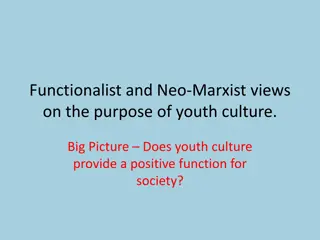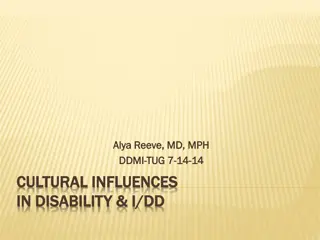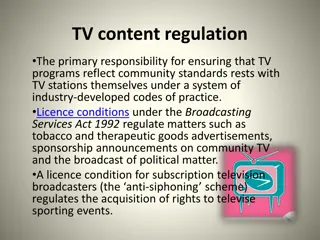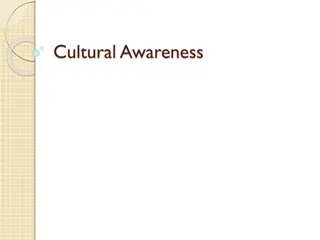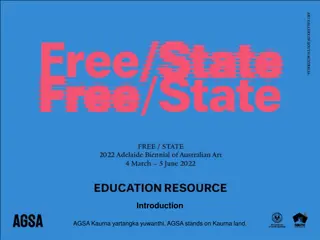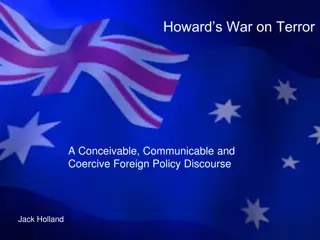Australian Subcultures and the Unique Case of Bikies
Subcultures in Australia encompass a diverse range of groups such as hippies, Goths, hip hop fans, and bikies, each holding distinct values and norms. Among these, the bikie subculture, specifically Outlaw Motorcycle Gangs (OMCGs), has been active nationwide, associated with criminal activities and rapid growth since 2007. Reactive subcultures, opposing prevailing norms, are also prevalent. Merton's subcultural theories further explore deviance as a response to societal values.
Download Presentation

Please find below an Image/Link to download the presentation.
The content on the website is provided AS IS for your information and personal use only. It may not be sold, licensed, or shared on other websites without obtaining consent from the author.If you encounter any issues during the download, it is possible that the publisher has removed the file from their server.
You are allowed to download the files provided on this website for personal or commercial use, subject to the condition that they are used lawfully. All files are the property of their respective owners.
The content on the website is provided AS IS for your information and personal use only. It may not be sold, licensed, or shared on other websites without obtaining consent from the author.
E N D
Presentation Transcript
Australian Subculture bikies
Subcultures Defined While small societies tend to be culturally uniform, large industrial societies are culturally diverse and involve numerous subcultures. Subcultures are values and norms distinct from those of the majority and are held by a group within a wider society. In Australia, subcultures might include hippies, Goths, fans of hip hop or heavy metal and even bikers - the examples are endless.
A deviant subculture is a subculture, which has values and norms that differ substantially from the majority of people in a society. When the structure of a neighbourhood or community favours criminal activity, a criminal subculture is likely to develop, such as the Mafia in the 1930s or inner city gangs today.
Bikies OCMGs are active in all states and territories and lists 44 as being of interest, with a total of 179 chapters and 4,483 members. There has been a 48 per cent increase of OMCG chapters since 2007, according to the ACC. Associated with criminal offences ranging from serious assault and kidnapping, to firearms, weapons, drugs, property and traffic offences Have links or ties with overseas chapters
Only OMCG originating in Australia Started in Brisbane a few decade ago Associated with drug manufacturing, tax evasion, theft and even murder!
Types of Subcultural Theory When looking at subcultures, we need to acknowledge two types of subcultures: 1. Reactive and 2. Independent..
Reactive Sub-Cultures A "reactive sub-culture" is one in which the members of a particular sub-cultural group develop norms and values that are both a response to and opposition against the prevailing norms and values that exist in a wider (predominantly middle- class or "conventional") culture. In this respect, this form of sub-culture is sometimes called "oppositional" rather than reactive.
Merton Subcultural theories build upon the work of Merton. They say that deviance is the result of individuals conforming to the values and norms of a social group to which they belong, if you belong to a social group whose norms differ from those of the main society then you will become a deviant.
Cohen Cohen said lower-working-class boys want to achieve the success which is valued by mainstream culture. But due to educational failure and the dead-end jobs that result from this they have little chance of achieving these goals. This results in status frustration, the boys are at the bottom of the social structure and have little chance of gaining a higher status in society.
This is similar to Mertons theory, however Cohen said that instead of turning to crime as Merton said, they reject the norms and values of mainstream society and instead turn to the norms and values of a delinquent subculture. In this subculture the boys can achieve success because the social group has different norms and values from the rest of society.
From this, we can identify that individuals may become a part of a deviant subculture like bikies, in an attempt to find social status, acceptance, power and authority that they may not find in the wider society.
Cloward and Ohlin Cloward and Ohlin attempt to take Merton's basic ideas and develop them into an explanation of why different social groups (specifically working class groups) choose to adopt different forms of deviance.
In basic terms: People are socialised to value "success". Those who have the means to achieve success do so legitimately (they follow "legitimate opportunity structures" - education, work and so forth). Those who are denied legitimate means still desire success, so they pursue illegitimate means ("illegitimate opportunity structures" - crime, in simple terms).
Independent Sub-Cultures In this form of sub-cultural grouping the members of the group are held to adopt a set of norms and values which are effectively "self- contained" and specific to the group. Where these values, in particular, differ from those of the wider culture within which the sub- culture exists, they may not necessarily (or consciously) be in opposition to such values.
However, what such sub-cultural values represent is an "independent" product of - and solution to - the problems faced by people in their everyday lives. An example of this type of argument is provided by Walter Miller in his article "Lower Class Cultures as a Generating Milieu of Gang Delinquency", 1962. As the title suggests, Miller rejects the idea that delinquent sub-cultures arise as some kind of "reaction" to the pervasive, dominating, influence of "middle class value systems".
Miller asserts 2 things: 1. It is possible to identify at least two distinct cultural groups; middle class and lower class. Each has its own distinctive set of basic values, beliefs, norms of behaviour and so forth, although it is evident that there must be some correspondence between the two - although what this might be is not specified
2. that lower class culture has certain values which do not exist within middle class culture.
Key Concepts 1. Non-Conformity Because people are seen as basically rational, their non-conformity to wider cultural values represents a calculated response to the behaviour of those in authority. Thus, the delinquent school-child trades-off the disapproval of teachers for the approval of peers. In this sense, conformity to school norms will get the child very little, While conformity to deviant norms will at least provide some form of social reward.
For theorists like Cloward and Ohlin, non- conformity to "mainstream" social norms is a result of the culture into which people are born. If they are socialised into a "deviant" working class culture, then they will exhibit deviant behaviour (in terms of wider cultural norms). For Miller, deviant behaviour is the result of over-socialisation into cultural norms that conflict with wider (middle class?) norms.
2. Power In common with Functionalist and ecological theories, there is again little discussion of a possible relationship between power, deviance and social control. Once again, sub-cultural theories tend to reflect the idea that there is a basic consensus in society over what constitutes crime and deviance
In addition, there is little, if any, discussion over how laws come to be created in the first place and little sense in which various cultures possess differential access to power in society. For example, although reactive sub-cultures are clearly oppositional in their impact, there is little or no analysis of the basis of the power which some groups clearly possess in order for such reactive sub-cultures to develop.
Your turn.. What type of subculture do you think bikies belong to? Reactive or independent? Give reasons for your answers!













